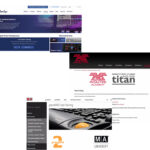Automated lighting fixtures are filled with many different effects and mechanical abilities. In addition to gobos, colored glass, shutters and irises, many fixtures provide a prism effect. While similar to a gobo, inserting a prism into the optics of an automated light can have many different results. An automated lighting programmer should understand the reactions and controls when using prisms. The Visual Effect
According to Wikipedia, a prism is a transparent optical element with flat, polished surfaces that refract light. At least two of the flat surfaces must have an angle between them. The exact angles between the surfaces depend on the application.
The type of prism commonly used in automated lighting fixtures is known as a “beam splitting” prism. As the name implies, a beam of light entering the prism will be broken apart into different identical portions according to the number and layout of facets on the physical prism. The number of facets will dictate how many identical images will appear from the fixture’s lens. The arrangement of the prism’s facets will place the multiple images in various layouts such as triangular, round, or linear. For instance, your fixture may have a three-facet triangular prism, eight-facet round, or four-facet linear prism. Each of these will provide a unique look when combined with other attributes of the light.
The Insertion
While some fixtures may place a prism in a rotating or fixed gobo slot, most prisms are on their own unique “arm.” This function allows the prism to enter the light path no matter what other options are enabled. Some arms actually hold two prisms and allow the programmer to choose one or the other. In this case, you cannot use both prisms at the same time, so it is important for you to understand how the actual fixture works.
Typically, the prism is placed in the very front of the optical system near the exiting lens. If the fixture also includes a zoom lens, there may be certain locations where the prism cannot be put into the path, as it would physically collide with the zoom lens. Depending on the fixture manufacturer’s software, they will either automatically move the zoom to another position to allow the prism to enter the path, or they will simply ignore the command to engage the prism. In either case, the programmer must understand both the physical restraints and the fixture software in order to maximize her/her programming. For example, if you have the prism in and run the zoom the full amount, it may kick the prism out automatically. As this is not the expected result, you may think something is wrong with the fixture or your programming. I will often take the cover off a fixture and study its behavior so that I understand exactly what is occurring as I change the settings.
Prism Parameters
When programming a fixture with a prism, you many have several channels of control. First, you will have a channel to choose to insert or remove the prism(s). A static prism in an automated light is rather boring, so most manufacturers allow rotation of the prism similar to a gobo. You will have a channel to select the direction and speed of the rotation (or even an indexed position). If the prism is rotating in the same direction of the gobo, then the visual image could synchronize and not appear as dynamic. In most cases, you will want to rotate the prism in the opposite direction of the gobo rotation.
Some manufacturers have begun adding in an effect to physically move the prism forward and backwards within the lens system. This feature may be called “prism lineation,” “prism divergence,” or other similar terms.
The location of the prism within the optical path will determine the spread between the facets of the exiting light. For example, at one setting, the facets may overlap, while at the opposite position, the facets are spread apart.
This setting is typically one channel that will move the prism from one end of the optical path to the other. You could even build a chase or effect that allows for continuous movement, which looks amazing as the facets spread apart and back.
Note that depending on the placement of the zoom lenses, it may be possible to achieve different looks, depending upon which side of the lens the prism is inserted. Again, the fixture manufacturer will determine the possibilities within the fixture firmware.
Creativity
Many different looks can be created when using a prism. From fanned out looks with a linear prism to cone patterns with a multi-facet round prism, the possibilities are endless. Gobo images can be multiplied for projection purposes, and some programmers even use a prism to gain more coverage by widening the open beam. One of my favorite tricks with a prism is to iris in or make a unique shutter cut. When these reduced-aperture shapes are put through a prism, some very bold looks are possible.
Interesting Effects
Remember that a prism is shifting the light output, so often it may be difficult to achieve a crisp optical focus of an image as when the prism is removed. However, this also allows for some unique potential with certain color mixing systems. When you combine partial saturation colors with a prism, it is possible to see some interesting color striations or aberrations. Of course, this depends on the fixture’s optics and the current focus/zoom settings, but I have seen some amazing looks.
In addition to the common prism types mentioned previously, some manufacturers make use of step prisms or other distinctive glass structures. A step prism looks like a series of different pieces of glass stacked together but slightly offset (thus the step name). When used with a gobo image, the gobo will appear to spread out in a linear fashion while showing a single stretched image. This tends to make for an almost 3D look with certain gobos or effects. There are multitudes of different creative glass pieces that have been used in automated lights, so be sure to see what is included in every fixture you use.
The Usual Disclaimers
The exact effects and usage of prisms within automated fixtures varies greatly from manufacturer to manufacturer. Be sure to read the user manual and DMX chart for your particular fixture to determine what is possible and how to access the parameters. Furthermore, check your console’s fixture library to ensure that it matches the DMX chart and provides you with all the fixture’s abilities. Plus, you may want to rename or reposition the parameters as described in your desk. When working with a visualizer, remember that a prism is an optical effect, so often the graphic on your screen may not match real life.
Working with prisms can be exhilarating and filled with creative possibilities. I find it a joy to use a prism to further alter the output of an automated light and see what unique looks I can produce. Prism effects are not just for DJs and nightclubs, so start using them creatively and have fun!



